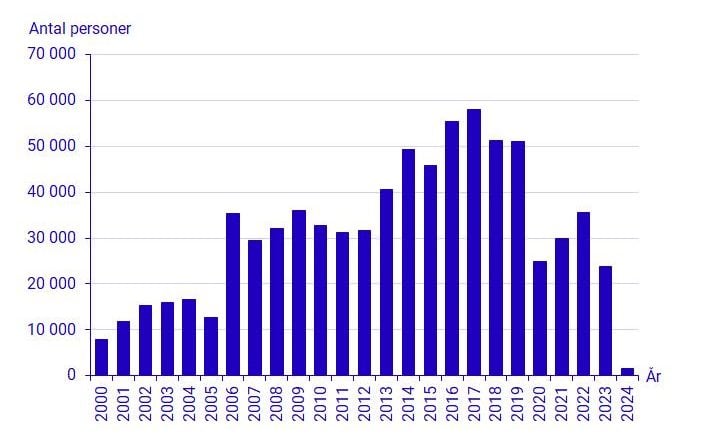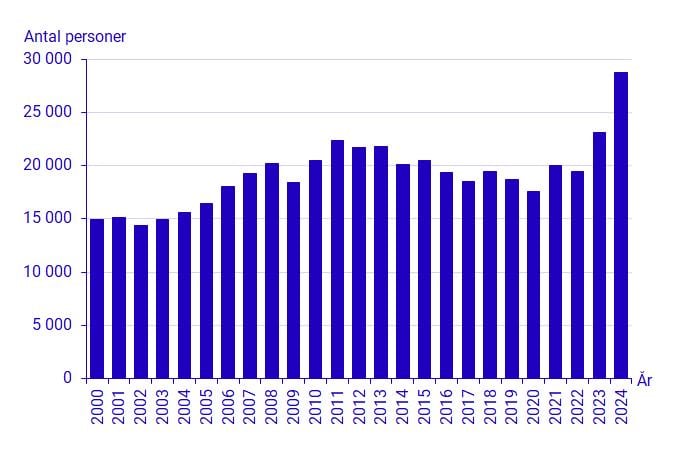Population size is not only affected by the number of people who are born and who die in a given year, but also the number of people immigrating and emigrating.
Although the number of children born in the first half of this year was low – the lowest for 21 years, to be exact – that’s not the only reason population growth was so much lower than usual.
“In recent years and in the first half of 2024, fewer children were born than in previous years, but the low population growth in 2024 is primarily due to the fact that the number of people registered as emigrating from Sweden has grown,” Statistics Sweden population statistician Ann-Marie Persson said.
To put the population growth of 1,600 people in the first half of this year into perspective, this figure has stood at over 20,000 every year since 2006, and at over 30,000 in 14 of those years. Between 2013 and 2019, population growth was well over 50,000, peaking in 2017 when the figure reached almost 60,000.
You can see just how low the figure for 2024 is in the graph below.
Population growth in the first half of each year between 2000 and 2024
So, how many people actually left Sweden in 2024? Well, the answer is complicated. Almost 44,100 people were registered as leaving Sweden, but that’s not exactly the same as the number of people leaving in a given year.
Number of emigrated people in the first half of each year between 2000 and 2024
Since 2023, the Swedish Tax Agency has been working to improve the population register by checking to see whether the people on it are actually still living in Sweden, and removing them from the register if they are not, so not all of the people registered as leaving Sweden in the first half of 2024 actually left then, some may have left earlier.
Most – but not all – of these people were registered as emigrating to an unknown country. The number of people registered as emigrating to an unknown country stood at 15,400 people, although not all of these people are necessarily outdated entries in the population register removed by the Swedish Tax Agency.
READ ALSO:
Even once this figure is removed, the number of people leaving Sweden was higher than usual, as you can see in the graph below.
“In the first half of 2024, 28,700 people were registered as emigrating to a listed country,” Statistics Sweden wrote in a statement. “Compared to the first half of 2023, it’s an increase of 5,700 people, or 25 percent.”
Number of emigrated people in the first half of each year between 2000 and 2024, with “unknown country” removed
Who left?
Among those registered as leaving, the most common country of origin was, perhaps unsurprisingly, Sweden, representing just over a quarter of the 44,104 total: 11,199 people. The next most common country of origin was India, with 2,837 Indians emigrating from Sweden in the first half of this year, followed by 1,968 people from Iraq, 1,804 from China and 1,762 from Syria.
Rounding out the top ten were Poland, Somalia, Germany, the US and Iran. This only records the country of origin of the people emigrating from Sweden, not the country they emigrated to, so it’s not necessarily the case that those emigrating were returning to their countries of origin.
And who came to Sweden?
In the first half of 2024, 41,400 people moved to Sweden, one percent (or 309 people) fewer than the same period in 2023. The largest groups here were people born in Sweden (5,200), Ukraine (4,700) and India (2,500).
These figures refer to the date where people registered in the Swedish population register, which may explain the large number of Ukrainians – only 300 were recorded as moving to Sweden in the same period last year. The boost this year is probably due to the fact that Ukrainians who arrived under the temporary protection directive and who have been in Sweden for at least two years were able to register in the population register from June 2024.






 Please whitelist us to continue reading.
Please whitelist us to continue reading.
Why population not grow it is also connected to preschool situation and policy fact that while on parental leave you can’t send your other kids to preschool it is huge factor for people to don’t have 3rd kid and more….